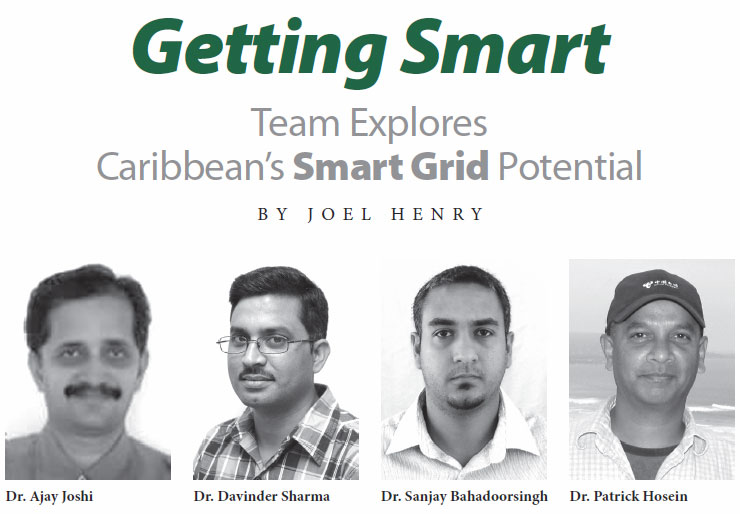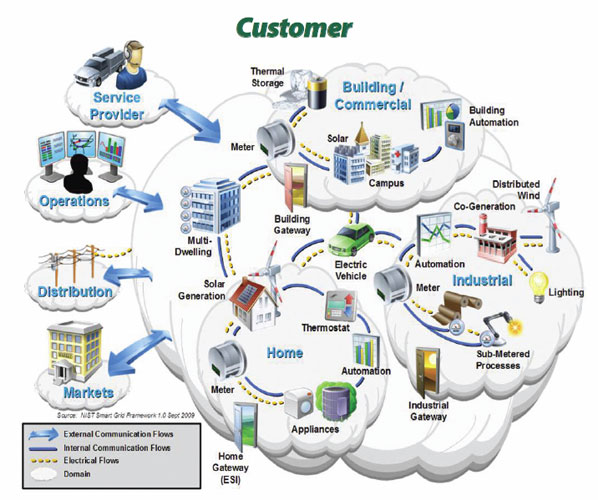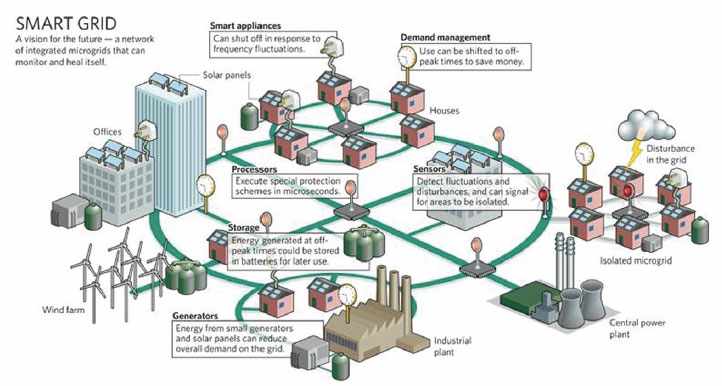
“Smart grids aren’t the easiest sell in an oil and gas rich country…. But fossil fuels are not forever. What could happen in 20 or 30 years? We have to think about the future.”
Now, more than ever, we love and need our devices. From mundane appliances such as refrigerators and air conditioning units, to the latest, imagination-capturing products of the technology revolution, our machines do far more than enhance modern life, they make it possible. But as our reliance on devices continues to grow, it puts an ever-increasing strain on our power generation resources.
In its 2013 Key World Energy Statistics, the International Energy Agency shows that global energy consumption rose from 4,674 million tonnes of oil equivalent (Mtoe) in 1973 to 8,918 Mtoe in 2013. Power grids (the energy infrastructure that generates power and distributes it to the society) not only have to cope with this inexhaustible demand from industrial and domestic consumers, they are not equipped for the functionality provided by “smart” machines, devices that use information and communication technology (ICTs). We already have smart phones, smart refrigerators and smart televisions. Technologists are busily developing smart everything else.
The term for this shift towards ICT-enabled devices is “the Internet of Things.” It is one of the most popular trends in the technology industry – one for which traditional power grids are not prepared.
“The electrical grids that we are using now are based on 100-year-old systems. Nothing much has been changed and they cannot cater for the needs of the 21st century,” says Dr Davinder Sharma, Lecturer of Electronics in the Department of Physics at the Faculty of Science and Technology at The UWI’s St Augustine Campus.
 Dr Sharma is lead researcher on a university project to look into the potential for smart grid development in the Caribbean. The four-member UWI research team has embarked on a three-year project focused specifically on capacity building and research for the establishment of a smart grid in Trinidad and Tobago. Working with various government ministries and the State agency providers of electrical power and telecommunications, the team is laying the groundwork for what could in ten years become the Caribbean’s first smart grid. Dr Sharma is lead researcher on a university project to look into the potential for smart grid development in the Caribbean. The four-member UWI research team has embarked on a three-year project focused specifically on capacity building and research for the establishment of a smart grid in Trinidad and Tobago. Working with various government ministries and the State agency providers of electrical power and telecommunications, the team is laying the groundwork for what could in ten years become the Caribbean’s first smart grid.
What does this mean? If implemented, not only can the improved technology lower utility costs, improve reliability and lessen the environmental impact of the electricity grid, it will fundamentally change the relationship between power providers and consumers. At its heart, the technology revolution is about communication and a smart grid can replace the traditional unidirectional contact of generator to user with one in which both are users and sellers.
“Conventional electrical grids are built for a one-way flow of information,” Dr Sharma explains. “It flows from the power station to us. With a smart grid the consumer can participate in energy trading. We can install our own renewable energy systems. We can create our own solar farms and we can send energy back to the grid. And the grid will pay us for it.”
In other words, smart grids can create energy entrepreneurs (as in the US, UK and India). How seriously is this being taken? In 2013, the Government of India made the commitment to invest approximately US$10 billion to transform its power infrastructure to smart grids. In the US, policymakers have set a goal of 100 percent consumer participation in smart grid technology by 2035.
Trinidad, smart location for smart grid research
The UWI project, entitled, “Capacity Building and Research on Smart Grid Technology in the Caribbean Region,” began in May 2013. The summary states:
“Today, 80.6 percent of the world’s energy needs are dependent on fossil fuels which are depleting at a very fast rate. Countries all over the world are charting new ways to produce, distribute, deliver and use electricity… A new concept called Smart Grid is emerging… Most of the Caribbean islands are also dependent on fossil fuel-based sources for electricity generation. With the increase in demand and cost of electricity, these islands will soon have to find alternative economically sustainable sources of energy.”
Paradoxically, with its wealth in oil and natural gas, this is not the case in Trinidad and Tobago. Yet T&T is well-placed to host smart grid research and eventually establish a smart grid.
“This is a small country. It is easier to implement a smart grid in a small, controlled place,” says Dr Sharma. “Added to this, we have wealth, infrastructure and technology.”
And though T&T’s energy costs are the lowest in the region, Dr Sharma points to many other benefits to a smart grid. These include the previously mentioned opportunities for consumer participation in the power generation market, greater reliability and consistency of service due to smart grids’ capability for self-maintenance, and a reduction of the environmental impact of the nation’s power generation industry.
“We are worried about carbon dioxide emissions,” Dr Sharma explains. “Due to its abundant fossil fuel resources, Trinidad and Tobago has become one of the highest greenhouse gas emitting countries on a per capita basis. There is a need to develop smart grid technology to improve the energy efficiency of existing power grids to reduce costs and to allow a much greater utilisation of renewables in the grid to decrease greenhouse gas emissions.”
Phase One of the project (already underway) includes the creation of a network of stakeholder “field professionals.” Through this initiative, the UWI research team has assembled a group that includes players from T&TEC, TSTT, several ministries and TATT. The group held its first meeting in May 2014, an information sharing exercise through which the parties could discuss the project and operating environment.
Out of the meeting it was discovered that T&TEC has upgraded the vast majority of the country with “smart metres.” These are critical to establishing a smart grid, as Dr Patrick Hosein, Senior Lecturer in UWI St Augustine’s Department of Computing and Information Technology explains:
“Trinidad and Tobago’s major advantage is that almost the entire population has smart meters installed in their homes. These are only used to collect electricity usage information for billing purposes. However, this is a rich trove of data that can potentially be used to improve the efficiency of the grid as well as for detecting fraudulent usage.”
Dr Hosein is the member of the research team responsible for capacity building and research on wireless communications for the smart grid. Powerful, Internet-based communications technology is essential for a smart grid to function. Dr Hosein has included two of his students on the project.
“One of my MSc students, Sudesh Lutchman, has developed a platform (server) that can be used to collect sensor/metre data that is periodically generated,” he explains. “Applications can then be used to display appropriate information via the Web or mobile devices.”
Laura Bigram, one of Dr Hosein’s PhD students, is working with T&TEC to help improve their smart metre network and also process (or data mine) the information received from these devices. When asked what was needed for the success of the project, the UWI Senior Lecturer said, “brilliant students who are interested in this area of research. I already have a couple.”
Merger of ICT and power systems
Communications technology is one of three components required to implement a smart grid. The other two are high performance computing to control and regulate the grid and the numerous household and personal devices that will interact with it; and of course the power systems, both electrical and renewable such as solar and wind, which will utilise the grid.
Dr Ajay Joshi, Senior Lecturer in the Department of Electrical and Computer Engineering in the Faculty of Engineering, is responsible for overseeing the computing infrastructure and parallel software design aspect of the project.
“We need very powerful computers for a smart grid. One customer has at least 10 appliances and a thousand customers means thousands of appliances. This will generate a large amount of data, which in turn will require considerable computing capability. Dr Joshi’s research will allow us to acquire the capability to build and handle massive computational platform for this work.” Dr Sharma says.
“The module of SG technology being focused on is that of high performance computing. In particular, this accounts for the computing needs for building a high performance computing facility which includes a parallel computing machine, development of parallel algorithms and entails examining the existing computer infrastructure and integration challenges to determine whether or not it can address the needs of the grid,” says Dr Joshi, who has more than 15 years of experience in this area.
His MPhil student, Daniel Sooknanan, is developing algorithms and the application of high performance computing to facilitate the deployment of smart grids in the Caribbean.
As lead researcher, Dr Sharma has overall responsibility for the project, but his role is also modeling renewable energy systems for the smart grid. Essentially, this entails creating a model in which renewable systems like solar cells that are independent of the power provider can be attached and functional without disrupting the grid. It is through this interaction that the regular citizen can participate in the electrical power marketplace.
But this technology is very challenging to implement properly, as introducing new forms of energy to the grid can have a disruptive effect. This is why Dr Sharma has to create a model for the grid rather than carry out research on T&T’s electrical infrastructure. One of Dr. Sharma’s MPhil students, Miguel Andrews, is doing research on the modelling of fuel cells (another possible source of renewable energy in the Caribbean) for their integration with the smart grid.
“We can’t simply attach any renewable sources like solar panels and fuel cells to the grid, as this could destabilize or disturb the normal functioning of the grid,” he explains. “We need to understand the intermittent behaviour of renewable energy sources, especially solar and wind, before integrating it with the grid. That is why we are modeling these systems to develop an understanding of that behaviour.”
The fourth member of the research team, Dr Sanjay Bahadoorsingh, Lecturer of Energy Systems in the Department of Electrical and Computer Engineering at UWI is working closely with T&TEC on this project. His undergraduate student has developed a prototype for a smart grid low voltage disturbance detector and generator status monitor.
Following their networking initiative, the team has been involved in raising awareness and developing a cadre of smart grid “specialists” by hosting three events: a workshop on electrochemistry, emphasising fuel cell modeling by US-based firm Consol Inc; a forum on “Internet governance” (proper guidelines for the communications infrastructure are important for smart grid management); and a seminar on “Power Generation in Trinidad and Tobago.”
The aim is to generate interest among industry professionals who could eventually be involved in implementing a smart grid, as well as citizens. Smart grids aren’t the easiest sell in an oil and gas rich country.
“It is very difficult in Trinidad,” concedes Dr Sharma. “Countries like Barbados and Guyana are doing their own thing with smart grids but here in T&T people are not taking much interest. They will say that the cost of energy is so low, why should we be interested in this? But fossil fuels are not forever. What could happen in 20 or 30 years? We have to think about the future.”
Apart from their capacity-building exercises, the team continues its research into the computing, communications and power systems aspects of smart grid technology. Next on the agenda (in the project’s third year) is to provide formalised training on the technical aspects of implementing and managing the smart grid; establish a state-of-the-art Smart Grid Research Laboratory at UWI St Augustine; and prepare a green paper for the creation of a smart grid in Trinidad and Tobago.
But when all the research is collected and the human capacity is built, a decade from now, will Trinidad and Tobago have a smart grid? Dr Sharma believes it is possible.
“We have two major challenges,” he says. “At the policy level there is at present no policy regulating how people can connect renewable energy sources to the grid. At the technical level it is a major challenge integrating renewable energy resources to the grid because of their unpredictable behaviour. But this country is a good location for a smart grid because of its size and resources in terms of infrastructure and technology. Implementing a smart grid will not be expensive. It will mean a little upgrade to the infrastructure. 4G (fourth generation wireless Internet) communication can be used for the grid.”
For now, the UWI research team is working to complete every aspect of the three-year project so that when the nation has its flash of insight on the importance of smart grid technology they will be prepared to make it reality.
What is a smart grid?

A smart grid is an electricity generation and distribution infrastructure that uses information and communication technology to improve performance of the system. Smart grids integrate advanced sensing technologies, control methods and communications technologies into the contemporary electricity grid. It is a merger of ICT and power system engineering.
Smart grids:
- Use information technology to improve how electricity travels from power plants to consumers.
- Allow consumers to interact with the grid and participate in electricity market.
- Integrates new and improved technologies into the operation of the grid.
- Integrates renewable energy systems like solar and wind power into the grid.
|





